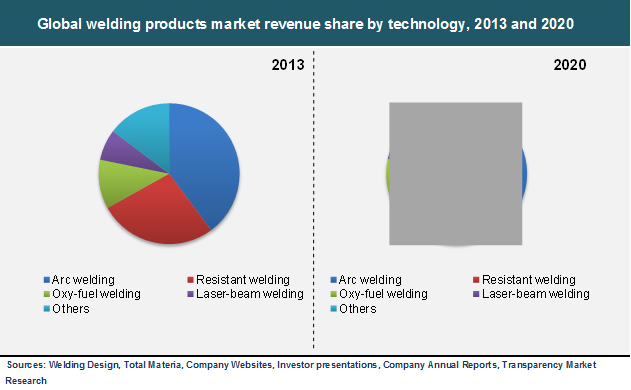Transparency Market Research (TMR) has announced the publication of a new research report, titled “ Welding Products Market – Global Industry Analysis, Size, Share, Growth, Trends and Forecast, 2014 – 2020”, to add to its market study database. TMR states that the global welding products market was worth US$17.47 billion in 2013 and is estimated to be worth US$23.78 billion by 2020, displaying a 4.5% CAGR between 2014 and 2020.The burgeoning automotive industry, combined with the developing building and construction industry, predominantly in developing economies, is driving demand for welding products. Welding has extensive use in the automobile industry in the manufacture of numerous components and for complex operations. In the energy sector, wind energy holds a large potential for welding products, mainly in emerging economies in Asia Pacific. Furthermore, construction of new wind turbines will contribute substantially to total revenue in the global welding products market.
Get Brochure of the Report @https://www.transparencymarketresearch.com/sample/sample.php?flag=B&rep_id=850
However, lack of skilled labor for welding processes in manufacturing industries, especially in developed nations, will challenge the market’s growth prospects. On top of this, high labor costs have also reduced the profit margins of major manufacturers.Welding is a fabrication process and, being in use since the industrial revolution, has undergone continuous technological advancement and introduction of newer welding techniques to offer to its large end user base. Forge welding was among the first used welding techniques; arc, resistant, solid beam, and oxy-fuel are some other welding techniques used across various end-use industries.Due to its versatility, arc welding is the preferred choice of end users, and hence commands a dominant share in the welding products market. Arc welding held a market share slightly below 40% in the overall welding products market in 2013. It was followed by resistance welding, laser beam welding, oxy-fuel welding, and others.

Enquiry Before Buying: https://www.transparencymarketresearch.com/sample/sample.php?flag=EB&rep_id=850
Amongst end users, building and construction emerged as the largest application segment, accounting for 17% of the global welding products market in 2013. Welding is extensively used in commercial and residential building projects. In the coming years, increasing demand for welded steel will lead to increasing demand for welding equipment and consumables from the construction sector.The rapidly growing construction industry in Asia Pacific holds promise for the welding products market in the region. Other key application areas of welding products include automobiles, marine, and transportation. In 2013, Asia Pacific led the global welding products market, occupying over 40% of the total market in the same year. The region was followed by Europe, which is estimated to have a declining market share in the coming years, due to demand-supply gap in raw materials and the eurozone economic slump. The RoW and North America regions collectively held approximately 32% of the total market in 2013.